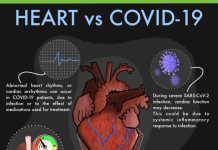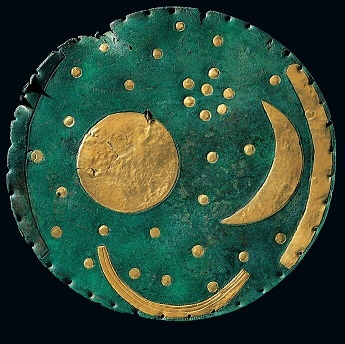The Nebra Sky Disk has inspired the logo of the space mission ‘Cosmic Kiss’. This space mission of the European Space Agency is the declaration of love for space.
Ideas from observation of night sky played important role in religious beliefs of ancient civilisations. Generally, ancient societies had some notion of the interplay of stars and planetary bodies on human lives. However, there are few direct physical evidences of this. Nebra Sky Disk, the 3600 years old bronze disk found in 1999 in Mittelberg near Nebra (Saxony-Anhalt, Germany) is unique because it is the oldest concrete physical depiction of cosmic phenomena. Considered to be the most important archaeological discovery of the last century, Nebra Sky Disk was included in the list of UNESCO’s The Memory of the World Register in 2013 (1).
The Disk’s discovery in 1999 was not in the normal archaeological excavation under supervision of experts. Instead, it was found by private persons in an illegal excavation along with few other artifacts and was in illegal possession of antique dealers until 2002 when it was seized by the Swiss Police in a raid and returned to the State subsequently following court proceedings. The extraordinary situation associated with its discovery had posed several issues including its dating. Some experts doubted its early Bronze Age origin and suggested its origin could be thousand year later in the Iron Age instead (2). However, a more detailed later study used an interdisciplinary approach to determine the origin and confirmed the Nebra Disk to be of early bronze age (3,4,5).
Interestingly, one of the papers submitted to the preprint server suggests Nebra Disk to have evidences of the earliest supernova observation (6). If this disk is an illustration of the night sky then the large sun-like object in the disk could probably be some extremely bright sun-like star.
The Nebra Sky Disk has inspired the logo of space mission ‘Cosmic Kiss’. This mission is a declaration of love for space. Under this mission, European Space Agency’s astronaut Matthias Maurer will travel into space this spring making him the first German to do so (7,8).
***
Sources:
- UNESCO 2013. Memory of the World – Nebra Sky Disc. Available online at http://www.unesco.org/new/en/communication-and-information/memory-of-the-world/register/full-list-of-registered-heritage/registered-heritage-page-6/nebra-sky-disc/ Accessed on 19 January 2020.
- Gebhard R., and Krause R., 2020. Critical comments on the find complex of the so-called Nebra Sky Disk. Archäologische Informationen. Available online at https://www.dguf.de/fileadmin/AI/ArchInf-EV_Gebhard_Krause_e.pdf Accessed on 19 January 2020.
- State Office for Monument Preservation and Archeology Saxony-Anhalt 2020. Press release – Science Thriller Solved: The Nebra Sky Disc Dates from The Early Bronze Age. Published 13 November 13 2020. Available online at https://archlsa.de/oeffentlichkeitsarbeit/presseinformationen/131120-datierung-himmelsscheibe.html Accessed on 19 January 2020.
- Austrian Academy of Sciences.The Nebra Sky Disc dates from the Early Bronze Age. Available at https://www.oeaw.ac.at/news/the-nebra-sky-disc-dates-from-the-early-bronze-age#
- Pernicka E., Adam J., et al. 2020. Why the Nebra Sky Disc Dates to the Early Bronze Age. An Overview of the Interdisciplinary Results. Archaeologia Austriaca 104, Austrian Academy of Sciences 2020, pp. 89-122. DOI: 10.1553/archaeologia104s89.
- Pizzone RG., 2020. Evidences of the earliest Supernova observation in the Nebra disk. Preprint arXiv:2005.07411. Submitted on 15 May 2020]. Available online at https://arxiv.org/abs/2005.07411
- German Aerospace Center (DLR) 2020. News – The ‘Cosmic Kiss’ mission – a ‘declaration of love’ for space. German ESA astronaut Matthias Maurer will fly to the ISS in autumn 2021. Published 14 December 2020. Available online at https://www.dlr.de/content/en/articles/news/2020/04/20201214_matthias-maurer-mission-2021_en.html Accessed on 19 January 2020.
- ESA 2020. Cosmic Kiss mission patch. Available online at https://www.esa.int/ESA_Multimedia/Images/2020/12/Cosmic_Kiss_mission_patch2 Accessed on 19 January 2020.
***




































